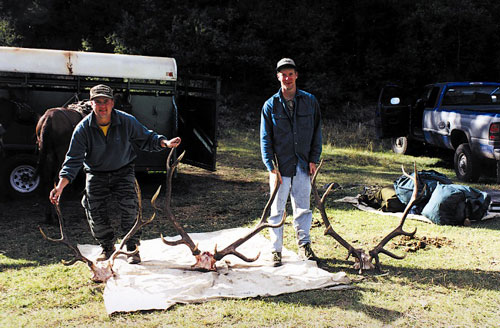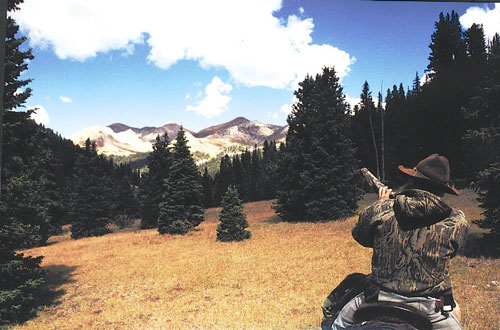 If you primarily bowhunt whitetail in the eastern half of the United States and are considering stepping it up a notch to pursue elk in the West, there are more than just a few things you need to consider before you start packing the SUV for a trip to the Rocky Mountains.
If you primarily bowhunt whitetail in the eastern half of the United States and are considering stepping it up a notch to pursue elk in the West, there are more than just a few things you need to consider before you start packing the SUV for a trip to the Rocky Mountains.
First and foremost, there’s the question and expense of hiring an outfitter. After attempting a few “do-it-yourself” and “save-a-dollar” elk hunts, I was quick to admit to myself that: 1) I didn’t save very much money, and 2) a good outfitter, not just any outfitter, and his horses are worth their weight in gold.
If you’re like me, when you first started bowhunting whitetail or turkey, your father, an uncle, or a friend helped you get started the right way. This person probably also taught you what not to do as much as he put you on the right path for successful bowhunting. Nevertheless, many bowhunters from the East still insist on heading West on unguided elk hunts even though they know very little about elk and have never seen a bull in the wild.
After all, an elk is just a big whitetail, isn’t it? Even after reading everything I could find on elk hunting and before I went on my first elk hunt, I admit I answered “yes” to that question. If you are also inclined to the same bad judgment, just keep reading.
Set A Budget
Although I am now a definite proponent of using the best possible outfitter and guide when elk hunting, I am only advocating their use when it fits your budget. That’s right. Before you decide whether you will be hiring an outfitter, you need to estimate the cost. Precise budgeting may not seem like a big deal when you return home with a Pope & Young bull, but see how it makes you feel after hunting nine days without ever seeing an elk. My first elk hunt was an unguided, over-budget, 11-day trip through the mountains of Hell or Idaho (I still confuse the two), which left me wondering how an enormous 800-pound animal could be so difficult to locate.
Begin your planning by determining how much you are willing to spend on an elk hunt. Next, list every conceivable expense associated with the hunt. If you are lucky and your expense list is less than what you are willing to spend, it’s time to go hunting. If not, you must cut corners. Please note that at some point during the cost-cutting phase, it might be wiser to wait a year while you stash away a few more dollars. This is especially true if you have never hunted elk and cannot afford the services of a reputable outfitter.
This brings us back to the big question—guided or unguided? The most significant expense to consider is an outfitter. Treat interviews with potential outfitters as you would any other major business transaction. Obtain a complete list of all things included in the price of the hunt—and all that are not included. Some hidden additional costs may include:
- Trophy fees.
- Transport of your elk to the meat processor.
- Caping and caring for your trophy.
Take into consideration the cost of:
- A license.
- Meat processing.
- Tips.
- Personal transportation.
- Meals.
- Lodging while traveling.
Also include a fund for equipment that you forget to bring and need to purchase upon arrival.
On the other hand, if you are still leaning toward an unguided hunt, there are costs you may not have considered. If you are going to be the outfitter, guide, camp cook, and wrangler, you will probably have to buy or rent some equipment. For example, you will need:
- Sturdy pack frame or rental horses to transport equipment and meat.
- A tent.
- Small cooking stove and equipment.
- Lantern
- Water purifier.
- Collapsible water jugs.
- Dehydrated food.
- First Aid equipment for base camp.
- Lightweight backpacking equipment in case the elk are not where you expect them to be—they never are.
Get the picture? By the time you purchase or lease all of your equipment, you may have spent considerably more for an unguided hunt than a guided one.
Driving Has Its Advantages
 A way I’ve found to cut costs is to drive rather than fly to my hunt location. Not only will gasoline be cheaper than airfare, but you can save money transporting your meat and trophy. In 1998, I harvested my elk on the last day of the hunt and was flying out of Jackson Hole, Wyoming. Because the meat processor could not have the meat cut, packed, and frozen before my departure, my only option was to ship 400 pounds of elk meat second-day air. My processing bill was $150 while the freight was more than $400.
A way I’ve found to cut costs is to drive rather than fly to my hunt location. Not only will gasoline be cheaper than airfare, but you can save money transporting your meat and trophy. In 1998, I harvested my elk on the last day of the hunt and was flying out of Jackson Hole, Wyoming. Because the meat processor could not have the meat cut, packed, and frozen before my departure, my only option was to ship 400 pounds of elk meat second-day air. My processing bill was $150 while the freight was more than $400.
If you are lucky enough to harvest an elk early in the hunt and the meat is frozen by the time your flight leaves, you can bring the meat on the flight and send your gear back ground parcel. This also provides considerable savings. If you still need to cut expenses, consider a shortened hunt or applying for a less expensive license and tag. In states like Wyoming and Montana, you can apply for less expensive tags, but your chances of drawing are also less. Finally, you may want to consider a two-on-one guided hunt rather than a one-on-one guided hunt. No matter what you decide, keep in mind that elk always seem to have the luck on their side and you don’t want to cut any more corners than absolutely necessary.
Next: Extra Equipment Saves The Hunt; Bring Duplicates, Get In Shape






